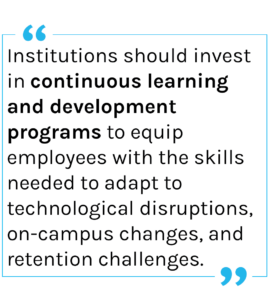by Robert Perich, Ladina Rageth, Danya He and Maryna Lakhno



Higher education is at a crossroads. Across Europe and beyond, higher education institutions (HEIs) face increasing financial constraints, shifting political landscapes, and the growing challenge of digital transformation. In this turbulent environment, leadership is not just about managing institutions – it is about navigating uncertainty and ensuring that HEIs remain resilient, innovative, and globally competitive.
Yet, are higher education leaders equipped for this challenge? A recent Swiss national study of senior leaders (detailed findings are available here) provides a reality check. Our study, the first of its kind in Switzerland, examined the career trajectories, competency sets, and strategic concerns of 312 leaders from 38 institutions. What it uncovered was both revealing and troubling: senior leaders felt largely unprepared for the mounting financial and structural pressures facing higher education.
HEIs are no longer just institutions of knowledge – they are complex organisations requiring financial stewardship, strategic foresight, and the ability to manage significant institutional change. And yet, many senior leaders step into their roles with little to no formal management training. In a period where every budget decision can mean the difference between institutional sustainability and decline, this skills gap is more than an inconvenience – it is a challenge.
Who runs Swiss HEIs today?
The study reveals a leadership demographic that is surprisingly homogeneous. Despite years of diversity initiatives, Swiss HEI leadership remains overwhelmingly male (68%) and Swiss (80%). The average senior leader is in their mid-50s, has spent nearly 14 years at their institution, and was more likely than not promoted from within. Internal hires outnumber external appointments (55% vs 45%), and critically, almost 40% of senior leaders entered their positions without prior general management experience.
This reliance on internal promotion, while preserving institutional knowledge, raises an uncomfortable question: Are HEIs prioritising academic credentials and institutional loyalty over strategic and managerial competence? As budget cuts tighten and HEIs are forced to make hard choices, is it enough for leaders to understand academic culture, or must they also master the art of institutional strategy and financial sustainability?
The gap: what competencies do leaders need – and what are they lacking?
Swiss HEIs, like their counterparts worldwide, are complex ecosystems requiring a balance of academic credibility and managerial acumen. Yet, when surveyed, senior leaders overwhelmingly ranked leadership and strategic design capabilities as the most essential competencies, both of which require years of cultivation. They also emphasised managing organisational change, a competency that will become even more critical as institutions face increasing financial pressures and demands for efficiency.
The study highlights a concerning discrepancy between the skills leaders find most important and those in which they feel prepared. Many respondents wished they had received more targeted training in financial management, change leadership, and navigating the political landscape of higher education. Given that nearly half of respondents had never participated in formal leadership training before assuming their roles, it is clear that HEIs have largely relied on a ‘learn on the job’ approach to leadership development.
The perils of academic self-governance
One of the study’s most compelling findings is the tension between traditional academic self-governance and the need for growing professionalisation of higher education leadership. Research universities, in particular, still operate on a model where deans and department heads rotate through leadership roles while maintaining their academic careers. While this system ensures academic legitimacy, it creates discontinuity and limits long-term strategic vision.
By contrast, universities of applied sciences, where leadership positions are more commonly filled through open application processes, exhibit a different pattern: leaders tend to have more professional experience and stronger management backgrounds. This divergence begs an essential question: Is the tradition of academic self-governance still fit for purpose in an era that demands more decisive, financially savvy and agile leadership?
Budget cuts and the leadership challenge ahead
Financial sustainability is now the defining challenge of higher education leadership. The study underscores that senior leaders see budget constraints as the most pressing issue their institutions face, followed closely by digital transformation and the rising demand for research excellence and collaboration. While leaders anticipate increasing demands in these areas over the next decade, many institutions lack systematic training programmes to equip their leaders for these challenges. The findings suggest that without structured leadership development – particularly in financial strategy, political negotiation, and crisis management – HEIs risk falling into reactive rather than proactive decision-making.
Rethinking leadership development in higher education
The data from Swiss HEIs mirror trends seen globally: while the challenges facing HEIs have evolved dramatically, leadership preparation has remained largely static. The fact that nearly 40% of leaders entered their roles with no formal management experience is a stark indicator that institutions must do more to develop leadership talent early in academic careers.
Structured executive education programmes, mentorship initiatives, and cross-institutional leadership networks are critical. The study also raises the question of whether Switzerland – and other countries – should consider national leadership training programmes, similar to those in the Netherlands and Sweden, to systematically equip future leaders with the skills they need.
Indeed, other countries have already taken significant steps in this direction. For instance, the UK has developed a comprehensive suite of leadership development programmes through Advance HE, targeting leaders at various career stages across the higher education sector. Such initiatives provide a valuable model for how leadership can be systematically cultivated, and they underscore the importance of moving beyond ad hoc, institution-specific training efforts.
The future of higher education leadership: a critical juncture
HEIs are facing a defining moment. Financial constraints, political pressures, and the complexities of global education demand leaders who are not just respected scholars but also strategic visionaries. The findings from our study highlight the urgent need for HEIs to rethink how they identify, train, and support their leaders. Will higher education rise to this challenge? Or will institutions continue to rely on traditional models of leadership selection, hoping that academic merits alone will make their leaders fit for the complexities ahead?
Prof Dr Robert Perich is Academic Director, Swiss School of Public Governance SSPG, D-MTEC, ETH Zurich. He was CFO of ETH Zurich for 20 years and, as Vice President for Finance and Controlling, was responsible for financial strategy, budget management, asset management, risk management and the digitalisation of central processes. After completing his studies and doctorate at the University of St. Gallen (HSG), he gained 12 years of experience in various management roles at a major Swiss bank. In addition to earlier teaching activities at the University of St. Gallen, he currently lectures at D-MTEC and the University of Zurich (CHESS). He is also Deputy Chairman of the University Council of the University of Cologne.
Dr Ladina Rageth is Executive Director, Swiss School of Public Governance SSPG, D-MTEC, ETH Zurich. She is a social scientist with extensive experience in research and project management in the academic, public and private sectors. She completed her Master’s degree in Sociology at the University of Zurich and her PhD at ETH Zurich at the Chair of Educational Systems. Her research focuses on the sociology of education, labour market outcomes and the institutionalisation of education systems, with a current emphasis on the functioning and management of HEIs.
Danya He is Research Assistant, Swiss School of Public Governance SSPG, D-MTEC, ETH Zurich. She completed her Masters in Media and Communication Governance at the London School of Economics and Political Science (LSE) and worked as a research and teaching associate at the University of Zurich specialising in media and internet governance before joining the SSPG. She brings a wealth of experience in public institutions, media relations and legal affairs and has been recognised for her achievements in educational simulations such as the National Model United Nations.
Dr Maryna Lakhno is the Programme Coordinator at the ETH Swiss School of Public Governance (SSPG), where she manages the school’s continuing education portfolio and oversees its communication. Maryna also contributes to the design of the curriculum and programme activities and is actively involved in research projects within the school. Her doctorate in Public Policy under the Yehuda Elkana Doctoral Fellowship at Central European University in Vienna focused on integrating the United Nations Sustainable Development Goals within higher education. She was awarded the Swiss Government Excellence Scholarship for Foreign Scholars in 2022/23. She co-authored a comprehensive report for the Global Observatory on Academic Freedom.



